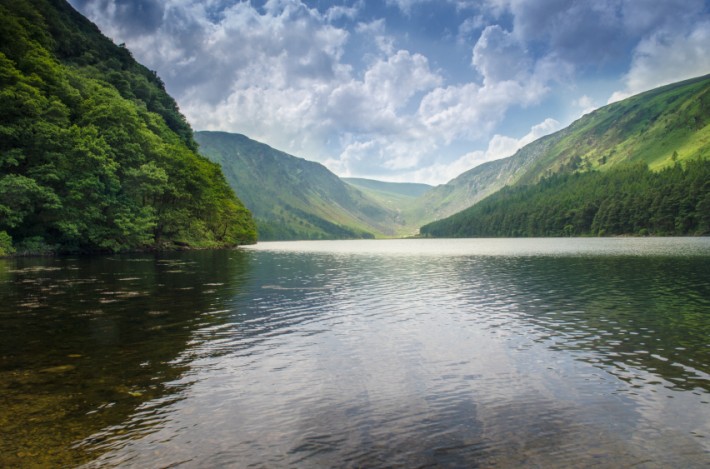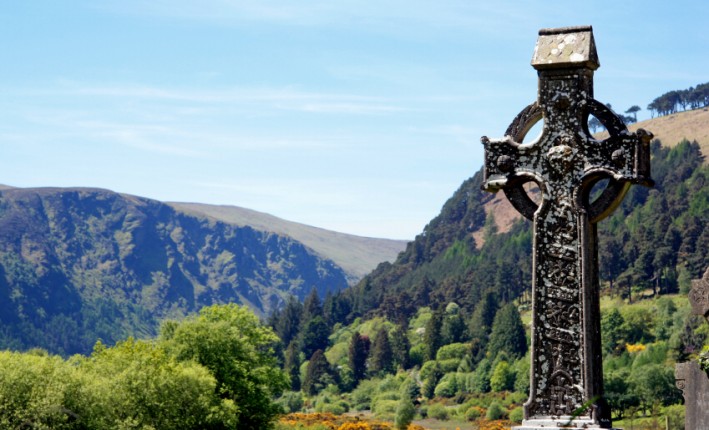The beautiful Glendalough, or glen of two lakes, is one of the most breathtaking sights in Ireland. This remarkable place has captured the imaginations of people for thousands of years and continues to do so.
Glendalough, in Wicklow, Ireland’s garden county, is renowned for its Early Medieval monastic settlement founded back in the 6th century by Saint Kevin; its extraordinary scenery, archaeology and rich history.
 |
| Glendalough, County Wicklow, Ireland |
The Glendalough Valley, located in the Wicklow Mountains National Park is famed for its stunning lakes and valleys and Wicklow Way walking paths. The iconic monastic site with Round Tower has become one of the most recognized symbols of Ireland and can be seen in many photographs and paintings.
‘The Monastic City’ at the mouth of the Glendalough Valley features a number of hugely important monastic remains, in particular the much photographed 30m Round Tower. The monks deserted the settlement hundreds of years ago following many upheavals, but the stone monuments echo back to their simple way of life.
The Gateway
The Gateway to the Monastic City, with its two round-headed granite arches, is hugely important and is unique in Ireland. Visitors still walk through this ancient entrance, walking along the original stone paving. The building, which was originally two-storeyed with a timber roof features a stone inscribed with a cross on the west wall.
The Round Tower
The 30 meter high Round Tower at Glendalough would have served as a landmark, a bell-tower, a storage building and a refuge in times of attack. There were originally six wooden floors in the tower with ladders and the entrance is 3.5 meters from the base. The roof was rebuilt in 1876 using the original stone.
 |
| Glendalough Round Tower |
The Priest’s House
The Priest’s House is a small Romanesque 12th Century building in Romanesque style. It was almost totally reconstructed using the original stones in 1779 and has an interesting carving of a much earlier date on the lintel of the doorway. It is thought that it may have been used to house the relics of Saint Kevin.
The Cathedral
Just beyond the Priest’s House is a large granite cross (sixth or seventh century) and the “Cathedral”, the largest church on the site, with a nave, chancel and sacristy (11th and 12th century), and Saint Kevin’s Church.
Saint Kevin’s Kitchen
Saint Kevin’s Church is commonly known as Saint Kevin’s Kitchen. This is a barrel-vaulted oratory of hard mica schist with a steeply pitched roof and a round tower belfry (12th century). Approximately 200m east of the Church of the Rock is a cavity in the cliff which is known as Saint Kevin’s Bed or Hermitage.
 |
Saint Kevin's Church ("Kitchen")
|
Saint Kieran’s Church
Saint Kieran’s Church was discovered in 1875, but only the low walls of this church now remain. It is thought that it was probably built to commemorate the founder of Clonmacnoise, the other very important monastic settlement that had important connections with Glendalough back in the 10th century.
At the Glendalough site on the road to Laragh, to the right, stands Trinity Church (11th-12th century). Beyond the river about 1.5km to the east of the Cathedral is Saint Saviour’s Priory, a church with fine Romanesque carvings on the chancel arch and windows.
The remains of an old stone fort and three stone crosses can be found between the Upper and Lower Lake, and beside the Lower Lake another cross; all four are stations on the pilgrimage route at Glendalough. Near a small bridge by Saint Kevin’s Bed stands Reefert Church (11th century) with a nave and chancel.

|
| Glendalough High Cross |
Glendalough is one of Ireland’s most magical and enchanting places to visit at any time of year. Steeped in spirituality and history, there is truly nowhere like it in the world.